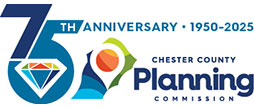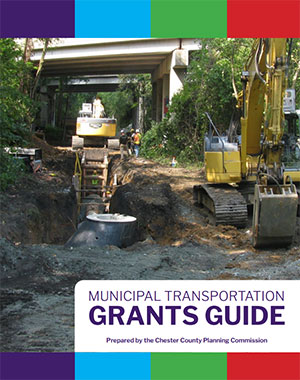Municipal Transportation Grants Guide
This webpage serves as a guide to help Chester County municipalities take their transportation improvement goals from concept to reality by increasing their knowledge of the grant and reimbursement program processes and to prepare them for the application process. View PDF
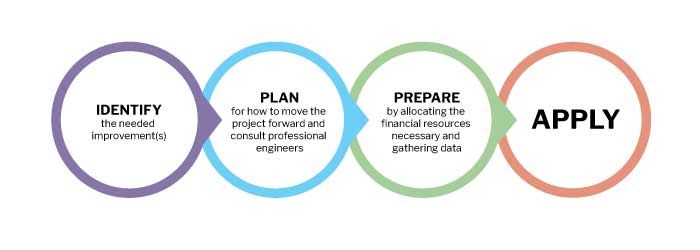
Things to Consider
Is your municipality expecting growth in the future?
Can any of your future needs be accomplished through private land development?
Creating an official map to help secure land for infrastructure improvements as it becomes available.
Some of the transportation funding opportunities available are reimbursement based, so it is important to budget for the full cost of the project before reimbursement funds are released, to recoup those costs through reimbursement.
Some projects may only cover construction costs, so design and engineering fees are expected to be funded by the municipality, or through another program.
Identifying Projects Through Planning
Consider any goals and reflect on any hierarchies included in existing community plans.
Capital Improvement Plans are a key element in prioritizing which infrastructure projects are essential to your community, and an important step in the conversation of how funds will be allocated to support those projects. While reflecting on current needs, creating a Capital Improvement Plan also gives the municipality the opportunity to reflect on future needs.
Most Capital Plans project 4-5 years into the future, but that can be adjusted to reflect the needs of your community. These plans are important to have in place for any community and are required for communities participating in ACT 209.
- Some of the transportation funding opportunities available are reimbursement based, so it is important to budget for the cost of the project before reimbursement funds are released.
- Other projects may only cover construction costs, so design and engineering fees are expected to be funded by the municipality, or by another program.
Comprehensive plans can be a great resource for projects within the community that have already been identified. Often a section about transportation needs or goals is included within such a plan.
Specific Project Plans — like corridor studies, multimodal plans, transportation studies, etc. can all be used to identify priority projects within your community. Even if the study is older, if the issue identified still poses a problem or has a need, it may be worth updating the data in the existing study for the purpose of moving the project forward.
Creating and adopting these plans also yields an opportunity for the public to weigh-in on what is important to them and helps to keep them informed about the community they live in.
Choosing projects to move forward with should be done with a knowledge of your capacity to manage those projects in mind. Most municipalities have the resources to have only one or two projects moving forward at a time.
Due to the resource allocation it takes to complete most transportation projects, it's important to budget and prioritize your needs.
Contributing your community's transportation projects to Chester County Planning Commission's biennial Transportation Improvement Inventory (TII)creates an opportunity for it to be advanced to the regional Transportation Improvement Program (TIP) or identified for other appropriate funding opportunities.
Which program is best for you?
If your community does not have a financial plan to achieve its infrastructure goals, a reimbursement-based fund may not be the right fit at this time.
The carrying costs of larger projects can be difficult for communities of any size to manage, so these types of funding programs may not suit the community if they are short staffed or have other limitations. This may also be true of a program with a more intense application process that requires a paid, experienced preparer. In this step, it's important to take inventory of your community's available resources and the best way to use them.
Working with Consultants
Finding the right planning and engineering firm for your municipality can take time. Some suggestions:

- Ask colleagues at other municipalities who they would recommend.
- Search websites of local firms to see examples of past work.
- Before contacting any firms, take the time to outline your needs and goals, and any hurdles associated with meeting those goals.
- Think about what would be involved in the building of the project(s) to ensure that you are finding the apporpriate firm for your needs.
This preparation will also assist you in interviewing a perspective firm. Chester County has a robust selection of engineering and consulting firms to choose from. Once you plan out what you would need from them, you could approach finding the right firm by looking at projects like your own and finding out who was involved in its inception. The Institute of Transportation Engineers (ITE) created a booklet named Best Practices in Selecting Transportation Consultants, which is a great resource for finding the right firm for your community. It can be found at www.ite.org.
Eligible Matching Funds
What is a local match?
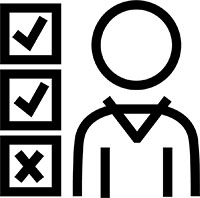
- A local match is a resource commitment made by the grantee and/or other local agencies to help implement the project as part of the grant agreement.
- In most cases, funding from one program may be used to further the project by covering the costs of design or engineering while another program may be used for the construction costs. Larger and more costly projects may require this kind of strategic financing. It may be necessary for your community to budget for the cost of design and engineering before engaging the help of consultants.
- Only in rare cases may federal funds be used as a match in federal funding programs; however, state funds are often permitted to be used as a match for federal programs.
- Local funds that can be used as a source for required matching include any tax revenue, vehicle registration fees, money from a general fund, municipal bonds, money from partner organizations, like Business Improvement Districts, or donated private funds.
- Money from the Liquid Fuels program is viewed as tax revenue. In some cases, money from the Liquid Fuels Program may be used as matching funds. They may also may be used to pay for project engineering (on any eligible roadway project) if the cost of engineering does not exceed 10% of the cost of the total project. Engage your PennDOT Municipal Services Specialist to ensure that the use of Liquid Fuels funds are eligible to use as a source of matching funds for your project.
The Benefits of Multi-Municipal Applications
Combining resources across communities to further project development can create several advantages.
- For communities with limited staff, this arrangement spreads the work across several individuals, creating a lighter load for everyone involved in the process.
- It also helps ease the burden of design, engineering, or carrying costs. For grants like ARLE, multi-municipal applications are encouraged and given priority. Most programs also accept applications from Councils of Government (COGs).
- This is a great option for projects that span or cross political borders (like bridges, intersections, or trails) or will benefit more than one community. Some federal grants are aimed at regional improvements and are best suited to projects that include multi-municipal collaboration.
Preparing a grant application can be time consuming. A best practice is to prepare your documentation before filling out the application. Many programs have application instructions or examples of previous applications online. Larger grant programs (federal) will provide feedback about your application package with the knowledge that the community may reapply during the next round of applications. These larger programs require a much more arduous application process, including a cost/benefit analysis, and should be completed by an experienced consultant.
Programs will often request the following:
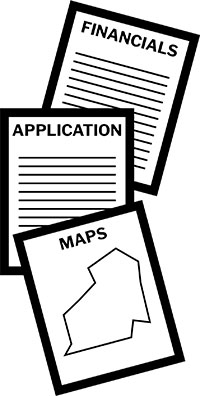
- project cost estimates
- funding commitment letters
- maps
- financial statements
- permits
- planning consistency letters
- sales agreements or appraisals
- letters of support
Tips for Creating a Competetive Application
A competitive application starts with preparations that began well before the notice of funding opportunity (NOFO) is announced. Project needs should be identified before the application is created. Data, along with a compelling narrative complete with visuals will help form a stronger application.
Some focus areas to help guide your application include:
- Is this project addressing safety concerns within the community? What data can you provide to support this?
- Is there a study or plan supporting this project?
- What other benefits could your project provide — are there economic benefits?
- Does this project benefit a low-income community somehow?
Visual tools like photographs, tables, charts, and other images can help tell your story and bolster your application. Common software like Microsoft word and Excel both have features to create visual aids. Google has a program called My Maps that can be used to create a map of the proposed project area.
Another tool to boost your application is a letter of support. Reach out to the Chester County Planning Commission and/or DVRPC and let them know about your goals and elicit their support. Their support will also demonstrate the project's compatibility with the region's comprehensive plans and goals (Landscapes3 and Connections2050).
Finding Data to Bolster an Application
The Chester County Planning Commission's Municipal Corner section of their website at Chescoplanning.org contains:
- Data
- Maps
- Project examples
- Applications for letters of support
- Links to funding resources
For trail projects, start by identifying if the project closes a trail gap or provides important connections between communities. The Department of Conservation and Natural Resources (DCNR) created a tool to help identify existing trail gaps on their website. Closing trail gaps can be funded in part by DCNR's Community Conservation Partnership Program, or C2P2.
Another place to find data to bolster your application is by searching products on the Delaware Valley Regional Planning Commission's website to see if there have been any studies done that pre-date your role with the community that would support the creation of your project. The DVRPC has a page devoted to data, including Census data, and maps showing communities of potential disadvantage in the region. To check for safety issues when planning a roadway improvement project, you can use DVRPC's Crash Data Viewer on their site at dvrpc.org.
For more information about roads and bridges, including ownership, average daily traffic, facilities, utility infrastructure locations, etc. PennDOT has a tool called OneMap. In this tool, you can choose your desired location and information (in the form of map layers) into a single spatial tool.
The following are a few examples of how municipalities used various funding opportunities to advance their projects.
Ship Road Couplet — West Whiteland Township
- With assistance from Traffic Planning and Design, Inc.
- Funded through transportation impact fees collected from developers and a PA Multimodal Transportation Grant. The upper 1/3 of the road and the trail were paid for through Multimodal Funds, and the other 2/3 were paid for by development fees and was built by the developers.
- Identified in the township's 2015 Capital Improvements Plan and included in subsequent studies.
- This project improved intersection operations and added a future Chester Valley trail connection while accommodating growth and preserving an existing historic structure.
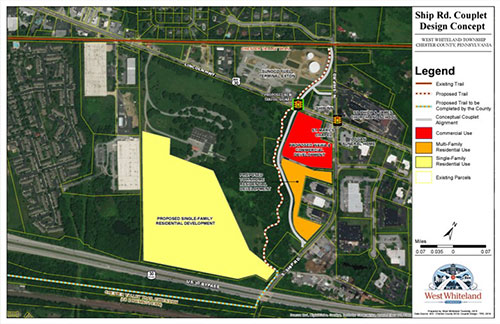
Transit Center Access Improvements — Oxford Borough
- With assistance from Bowman Consulting Group, Ltd.
- Funded through the Chester County Community Revitalization Program, PA DCED Multimodal Transportation Fund, PennDOT Multimodal Transportation Fund, PA DCED Keystone Communities Program, and a $20,000 private donation.
- Identified in the Borough's Active Transportation Plan
- This project created a safe and inviting pedestrian walkway between the center of the borough and a new parking garage and included roadwork, streetlights, sidewalk and curb improvements.
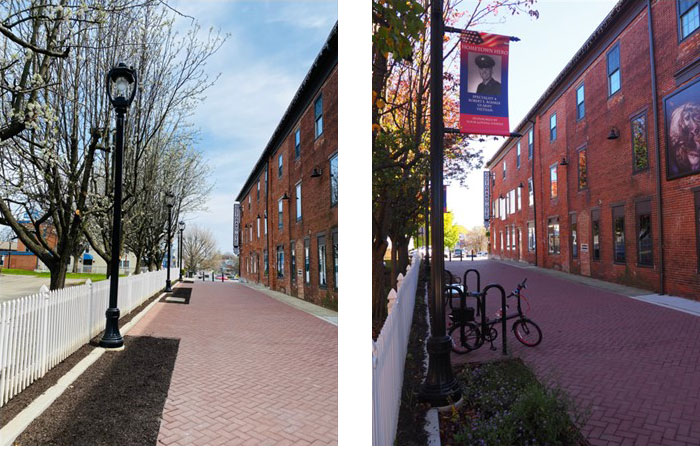
Paradise Street Improvements (Phase I and II) — Phoenixville Borough
- With assistance from Bowman Consulting Group, Ltd.
- Funded through Chester County's Community Development Block Grant and funds allocated by the borough over time.
- The phased improvements to Paradise Street provide the necessary infrastructure to make emergency service responses faster and safer for both first responders and the community at large.
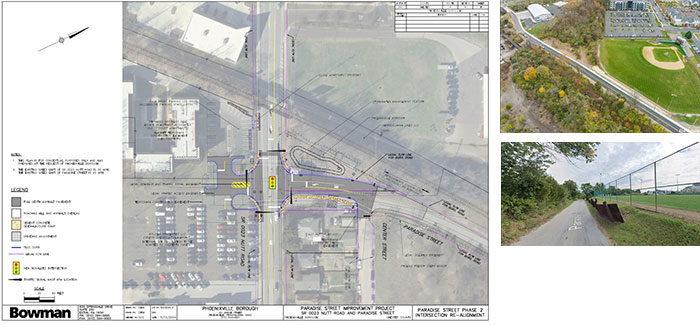
Rubric of Programs and Guidelines
The matrix below contains programs aimed at transportation funding and community development and is not an exhaustive list. For more funding programs, visit our Municipal Corner.
Transportation Funding
| Transportation Type Funded |
Program | Administering Agency/ Funding Stream |
Application Window |
Match Requirements |
Funding Available |
Eligible Activities |
|---|---|---|---|---|---|---|
| All Modes | Community Revitalization Program | Chester County Department of Community Development Visit Website |
February-March, yearly | 75/25, Variable | $5M available | PE/ Design/ ROW/ Construction |
| All Modes | Local Share Account (statewide) | DCED/State Visit Website |
September-November, yearly | No Match | $25k-$1M | ROW/ CON/ 10% of award can go to PE/Design |
| All Modes | Community Development Block Grant (CDBG) | Chester County Department of Community Development Visit Website |
Spring, yearly | 75/25, Variable | Variable | PE/ Design/ ROW/ CON |
| All Modes | PennDOT Multimodal | PennDOT/State Visit Website |
September to November, yearly | 70/30 | $100K-$3M | PE/ Design/ ROW/ CON |
| All Modes | CFA (Commonwealth Financing Authority) Multimodal Transportation Fund | DCED/State Visit Website |
March-July, yearly | 70/30 | $100K-$3M | ROW/ CON 10% of award can go to PE/ Design |
| Intersection | Green Light-Go | PennDOT/State Visit Website |
December, yearly | 80/20 | No Min/Max | ROW/ PE/ CON |
| Highway | Congestion Mitigation and Air Quality (CMAQ) | DVRPC/Federal Visit Website |
Next Round TBD | 80/20 | $500K-$5M | CON |
| Highway | Dirt, Gravel & Low Volume Road Maintenance Program | CC Conservation District/State Visit Website |
Rolling Basis | No Match | $100K for dirt & gravel Rds. $200k for low-vol Rds. | CON |
| Highway | Alternative Fuels Incentive Grant Program (AFIG) | DEP/State Visit Website |
June and December, yearly | No Match | up to $300K | For the Purchase of 2+ Vehicles |
| Highway | Better Utilizing Investments to Leverage Development (BUILD) | DOT/Federal Visit Website |
October to January | 80/20 with exceptions for rural/ disadvantaged areas | Min.: $1M Rural/ $5M Urban Max$25M | Capital Projects/ Planning |
| Highway | WalkWorks | Department of Health/ State Visit Website |
April, yearly | No Match | Up to $3,000 | Planning/ Active Transportation Plans |
| Highway | Safe Streets & Roads for All | Federal Visit Website |
May-June | 80/20 | $2.5M-$25M | Planning/ Design/ PE/ CON |
| Intersection | Automated Red-Light Enforcement (ARLE) | DCED/State Visit Website |
June, yearly | No Match | $18M available | ROW/ PE/ CON |
| Bridges | Municipal Bridge Retro-Reimbursement Program | DVRPC/State Visit Website |
TBD | No Match, up to 80% reimbursed | No Min/Max | Design, PE/ ROW/ Utility |
| Trails | Community Conservation Partnership Program (C2P2) | DCNR/State Visit Website |
Closes early April, yearly | 50/50 | Up to $500K | PE/ Design/ ROW/ CON |
| Trails | Greenways, Trails, and Recreation Program | DCED/State Visit Website |
February-May, yearly | 85/15 | Up to $250k | Planning/ ROW/ CON 10% of award can go to PE/ Design |
| Trails | Regional Trails Program | DVRPC/Local Visit Website |
Closed May, 2024 | No Match | up to $200K | ROW/ Design/ Planning/ CON |
| Bike/ Pedestrian | Transportation Alternatives Set-Aside (TA Set-Aside) | DVRPC/Federal Visit Website |
TBD | Design/Engineering Serves as Match | $50K-$1.5M | CON |
| Bike/ Pedestrian | Safe Routes to School - associated with TA-set aside | PennDOT/Federal Visit Website |
May-September (every 2yrs) | No Match | $50K min for CON Up to $1.5M (soft cap) | Construction, Education, Outreach |
A special thank you to our committee, who provided thoughful ideas and insight into the challenges of obtaining transportation funding.
- Randy Waltermyer, AICP — Bowman, Inc.
- Pauline Garcia-Allen — Oxford Borough
- Justin Smiley, AICP — West Whiteland Township
- E.Jean Krack — Phoenixville Borough
- Erica Batdorf — North Coventry Township
Contact Us
Brian Styche, Director Multimodal Planning Division
bObfuscationstyche@Obfuscationchesco.org
Patty Quinn, Transportation Planner
pObfuscationquinn@Obfuscationchesco.org
